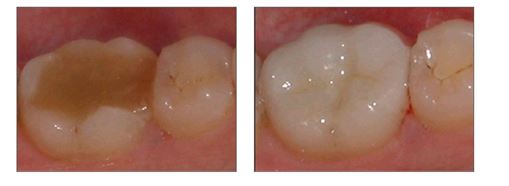
Dental Bridges
Bridges are used in some cases to replace missing teeth, a bridge is a false tooth that is attached to an anchor tooth or teeth. Great care must be taken to ensure the anchor tooth that will hold the false tooth in place is healthy and that the bite and condition of the gums are healthy and favourable to minimise the risk to the teeth and gums and the risk of overall failure.
Bridges are available on the NHS and privately, private bridges can be a very aesthetic option to replace missing teeth- please ask your dentist for the options that are appropriate to your individual needs. We have been working with the same laboratories for many years to help produce accurate and aesthetic bridges for our patients.
Example of an all ceramic bridge:

Ceramic Inlay on a molar tooth:
There are two main types of bridge commonly used:
- Conventional Bridges – this is a false tooth fused to a dental crown that is placed over the prepared anchor tooth/teeth. The NHS offer bridges made of metal and porcelain, however privately all ceramic bridges can be designed and fitted which can excellent results. The procedure for this bridge is the same as that for a dental crown- link to crown.
- Adhesive Bridges- this is where the false tooth is fused to a metal wing that is then bonded to the back of the tooth or teeth either side of the gap. Adhesive bridges have the advantage of being minimally invasive with minimal preparation often needed to the anchor teeth (which means less risks of complications to the anchor teeth and often less time in the chair). Privately metal free, all ceramic option are available that can be almost invisible and can also in the process remove unsightly amalgam (silver) fillings-ask your dentist for more information
Dental Bridges
Bridges are used in some cases to replace missing teeth, a bridge is a false tooth that is attached to an anchor tooth or teeth. Great care must be taken to ensure the anchor tooth that will hold the false tooth in place is healthy and that the bite and condition of the gums are healthy and favourable to minimise the risk to the teeth and gums and the risk of overall failure.
Bridges are available on the NHS and privately, private bridges can be a very aesthetic option to replace missing teeth- please ask your dentist for the options that are appropriate to your individual needs. We have been working with the same laboratories for many years to help produce accurate and aesthetic bridges for our patients.
Example of an all ceramic bridge:

Ceramic Inlay on a molar tooth:
There are two main types of bridge commonly used:
- Conventional Bridges – this is a false tooth fused to a dental crown that is placed over the prepared anchor tooth/teeth. The NHS offer bridges made of metal and porcelain, however privately all ceramic bridges can be designed and fitted which can excellent results. The procedure for this bridge is the same as that for a dental crown- link to crown.
- Adhesive Bridges- this is where the false tooth is fused to a metal wing that is then bonded to the back of the tooth or teeth either side of the gap. Adhesive bridges have the advantage of being minimally invasive with minimal preparation often needed to the anchor teeth (which means less risks of complications to the anchor teeth and often less time in the chair). Privately metal free, all ceramic option are available that can be almost invisible and can also in the process remove unsightly amalgam (silver) fillings-ask your dentist for more information


